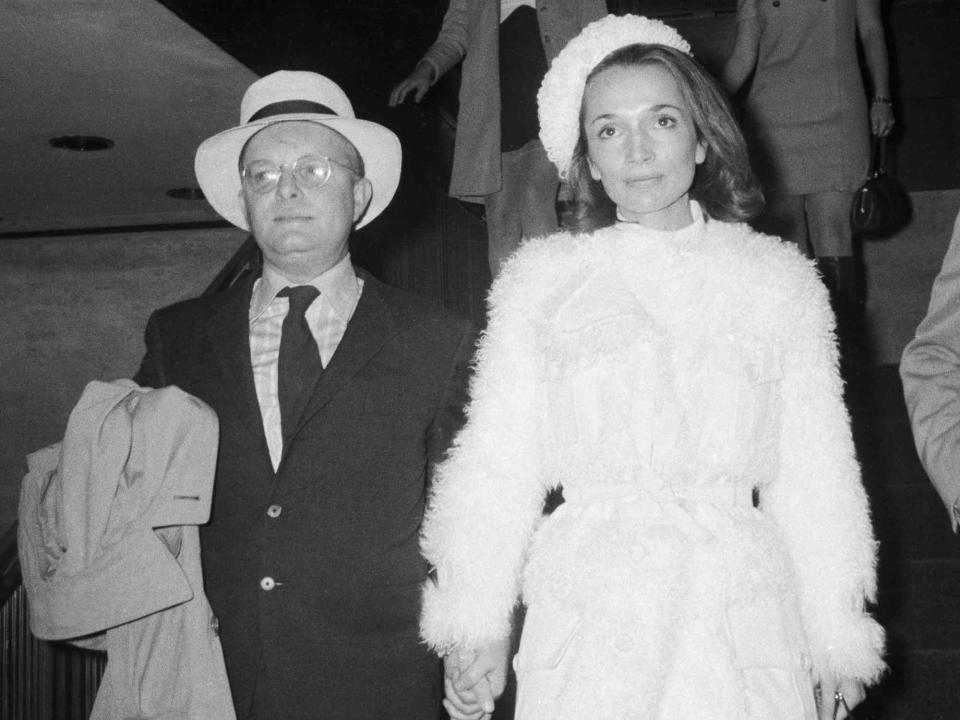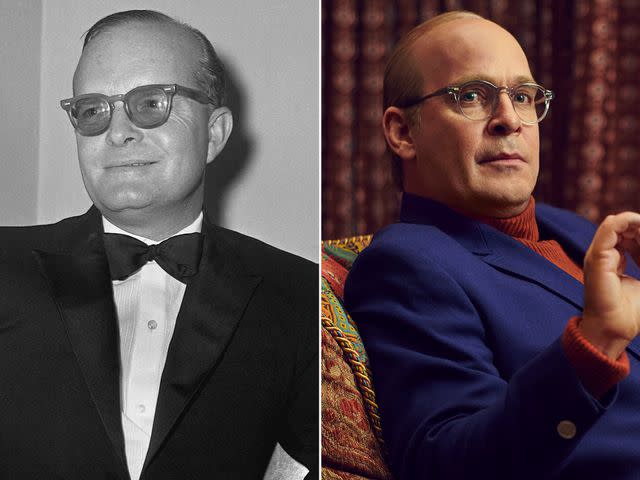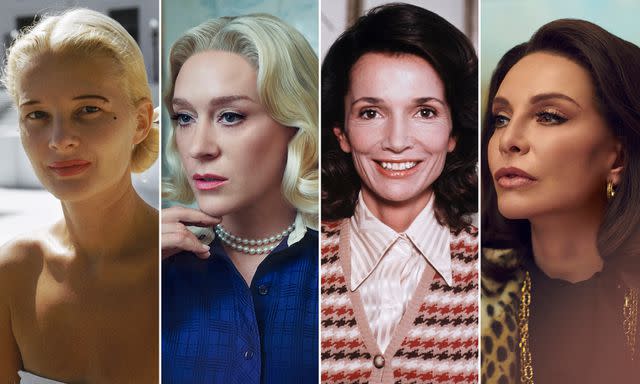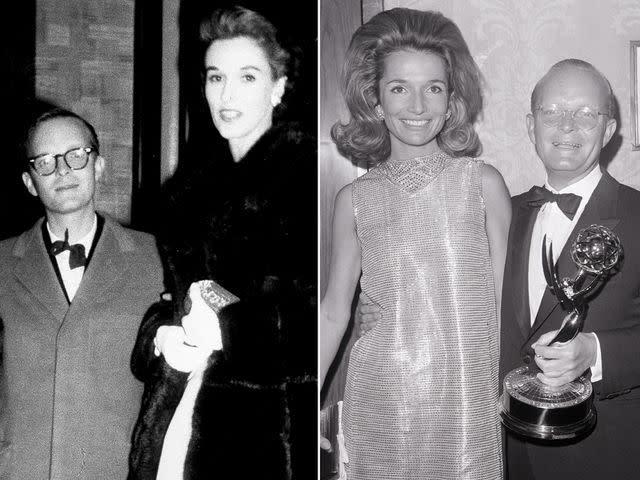The True Story of “Feud: Capote vs. The Swans”
- Oops!Something went wrong.Please try again later.
FX's new limited series depicts the rise and fall of author Truman Capote in Manhattan's most elite social circle

Bettmann
Truman Capote leaves a reception at The Four Seasons with Lee Radziwill on November 5, 1969 in New York City..Ryan Murphy's Feud: Capote vs. The Swans follows the real-life drama between author Truman Capote and his group of socialite friends, who he nicknamed the Swans.
The eight-episode limited series is based on the bestselling book Capote’s Women: A True Story of Love, Betrayal, and a Swan Song for an Era by Laurence Leamer. The Swans, which included socialites Barbara “Babe” Paley, Nancy "Slim" Keith, C.Z. Guest, and Lee Radziwill, were as thick as thieves, constantly seen together at some of the most notable parties of the era. Capote and the Swans were major names in 1960s and 1970s high society, and the author's whole personality was centered around his role in the illustrious community.
"He ingratiated himself with the richest and most elegant women in the world," Leamer told PEOPLE of Capote in 2021. "He decided he was going to write a book about them. He was going to learn everything he could about them for a number of years, and then write a masterpiece."
However, things went south between the Swans and Capote when an expert from his unfinished novel, Answered Prayers, was published in 1975, and though "fictionalized," the chapter contained the real-life secrets of the women in his life, including infidelity and murder accusations. It was easy to tell which character was supposed to portray which Swan, and ultimately, the betrayal would follow Capote for the rest of his life.
Gone were the days of living it up at high society parties. Capote was ultimately shunned from the community he once thrived and lost his friends, his lifestyle and his success as a writer.
FX's Feud: Capote vs. the Swans features Tom Hollander as the legendary author and a star-studded group of Swans including Naomi Watts, Diane Lane, Chloë Sevigny, Demi Moore, Calista Flockhart and Molly Ringwald. The series also marks the late Treat Williams' final project.
Related: All of the Glamorous Feud: Capote vs. The Swans Red Carpet Premiere Photos
From integrating himself into New York's high society to the project that would cause his demise, the true story behind Feud: Capote Vs. The Swans is gripping.
Ahead of the show's series finale, which airs March 13, here is everything to know about Truman Capote, the Swans and the deepest secrets the author revealed about his friends.
Who was Truman Capote?

Bettmann ; Pari Dukovic/FX
Truman Capote during the mid-1960s. ; Tom Hollander as Truman Capote in 'Feud: Capote Vs. The Swans'.Capote was born in New Orleans, Louisiana, on Sept. 30, 1924, to Lillie Mae Faulk and Archulus Persons. After being abandoned by his mother at a young age, he was raised by his aunts and cousins in Alabama. There, he formed a friendship with neighbor Harper Lee, who would eventually author To Kill a Mockingbird.
However, a young Capote would be reunited with his mother and her new husband, Joe Capote, when he went to live with her in New York as a teenager. He had loved writing from a young age and became serious enough about the craft that when he dropped out of high school, he quickly landed a job at The New Yorker at just 17 years old.
His stories caught the eyes of publishers, and two of his greatest creations, In Cold Blood and Breakfast at Tiffany's, became not only successful novels but also critically acclaimed motion pictures. When writing Breakfast at Tiffany's, Capote immersed himself in high society life. Being seen at all the best parties and gatherings, he claimed he was brainstorming for the novel, but his life in the spotlight would continue long after he put down the pen.
Capote was taken by the lives of the rich and famous, becoming close friends with the group that would become the Swans. However, it would be his career desires that would strip him of his high society status.
Related: See the Stars of Feud: Capote vs. The Swans Compared to the Real-Life Socialites They Play
Who were Capote’s Swans?

Slim Aarons/Hulton Archive/Getty ; Pari Dukovic/FX ; Bettmann ; Pari Dukovic/FX
C. Z. Guest at her ocean-front estate in Palm Beach, circa 1955. ; Chloe Sevigny as C.Z. Guest in 'Feud: Capote Vs. The Swans'. ; Lee Radziwell on March 4, 1976. ; Calista Flockhart as Lee Radziwill in 'Feud: Capote Vs. The Swans'.The Swans were a group of socialites who ran in New York City's high society that included fashion darlings like Barbara "Babe" Paley (Naomi Watts), Nancy "Slim" Keith (Diane Lane) and C.Z. Guest (Chloë Sevigny) and even royalty like Lee Radziwill (Calista Flockhart).
Paley was the grande dame of the group and the wife of CBS founder William S. Paley (Treat Williams). Having previously worked as a fashion editor for Vogue, Paley was the leading force of Manhattan's elite from the 1950s through the 1970s. In 1958, she made the International Best Dressed List Hall of Fame. She continued her life of glamor until she died in 1974 from lung cancer.
A veteran of the high life, Keith was introduced to the social scene by Hollywood actor William Powell. Her nickname "Slim" came from her former husband, Warner Brothers' mega-producer Howard Hawks — the man responsible for bringing Lauren Bacall and Humphrey Bogart together. Keith was a member of Capote's Swans but stepped away from her relationship with the author in the '80s when she found out the unflattering character Lady Coolbirth in Answered Prayers was about her.
Another fashion icon of the day, Guest was constantly on the best-dressed list, eventually landing in the Fashion Hall of Fame. She was a lover of horses, fashion and gardening and penned a gardening book with an introduction by Capote. For decades, she was considered one of the social circle's best hostesses and was even a muse to Andy Warhol and Salvador Dalí.
Finally, there was Radziwill, the younger sister of former first lady Jackie Kennedy, who was married to Polish aristocrat Prince Stanislaw Albrecht Radziwill from 1959 to 1972.
Related: From Growing up with Jackie Kennedy to Being a Princess: Lee Radziwill's Life in Photos
"Lee Radziwill was rich and deserving of being considered a swan. She was a beautiful woman," Leamer, the author of Capote's Women, told PEOPLE of Radziwill, who died in 2019. "She was married to Prince Radziwill, a fallen Polish prince; and she lived a totally glamorous life and Truman just loved her."
Other Swans included Ann Woodward (Demi Moore), Gloria Guinness, Marella Agnelli and Pamela Harriman, who all lived lives of luxury.
What caused their feud?
Capote and his Swans lived a glamorous life in New York City's high society, jet setting everywhere from the Hamptons, N.Y., to Paris and Venice, Italy. Whether they were throwing a party, attending events with celebrities, or sailing on yachts, they were the talk of the town.
However, Capote's intentions shifted. He started to take notes on the lives of his socialite friends, preparing to write a tell-all novel called Answered Prayers. While the book would remain unpublished, three excerpts — "La Côte Basque 1965," "Unspoiled Monsters" and "Kate McCloud" — were printed in Esquire in the mid-1970s, and once the Swans read what their friend had written, the feud began.
What did Capote write about the Swans in his tell-all book?

ullstein bild/ullstein bild/Getty ; Bettmann
Truman Capote and Barbara "Babe" Paley ca. 1957. ; Lee Radziwill and Truman Capote pose for the camera at the Emmy Awards on June 4, 1967.Capote revealed what really went on in the lives of his famous friends in "La Côte Basque 1965," which was published in Esquire in November 1975. The story centered around a group of high society women living double lives, from marital affairs to family in-fighting.
The story is supposedly about his closest friends, with Paley at the center of the controversies. Some Swans were in the published piece under pseudonyms, while the real names of others were given for all to see.
Paley — who once considered Capote her closest confidant — was hit hard by the accusations made in his piece. He wrote vividly of the socialite catching her husband in bed with another woman.
He also created a character named Ann Hopkins, a gold digger who killed her husband — indiscreetly accusing real-life Swan Ann Woodward of murdering her husband, William Woodward Jr., whom she shot in 1955 after mistaking him for a burglar, though the fatal shooting was ruled an accident. (Before the chapter was published, however, Woodward died by suicide).
Capote wrote about Radziwill, too, claiming that fellow Swans referred to her as "unrefined, exaggerated."
By and large, no Swan was safe from Capote's wrath in his writing.
What happened to Answered Prayers?
Following the publication of "La Côte Basque 1965" in 1975, two more excerpts from Capote's unfinished novel, Answered Prayers, were published in Esquire: "Unspoiled Monsters" in May 1976 and "Kate McCloud" in December 1976.
However, when Capote died in 1984, so did the manuscript of Answered Prayers, though the unfinished version was published posthumously in the United States in 1987.
His friends hoped to find the manuscript, but many believed he never finished writing it. Joanne Carson (Molly Ringwald), a close friend of Capote's, believed that the author did finish writing the book and hid it in a safe deposit box. She claimed he had given her a key but never shared the location of the alleged box.
In 2012, Vanity Fair discovered another unfinished chapter titled "Yachts and Things."
What happened to Truman Capote?

George Rose/Getty
Truman Capote in his Upper Eastside apartment living room in 1980.It shouldn't come as a surprise that Capote's relationship with the Swans never recovered — and his life was completely changed by his decision to publish the tell-all chapter. He became reliant on drugs, and by the late 1970s, he was in rehab for his addictions.
"He then became a social outcast," Leamer told PEOPLE of Capote's life after publishing his excerpts. "It was after that he began drinking heavily and taking drugs and dissipated and really never wrote what he could have written. The book never existed. He pretended he was writing it, but he didn't write it."
In 1984, Capote died of liver disease. He was 59 years old.
For more People news, make sure to sign up for our newsletter!
Read the original article on People.

